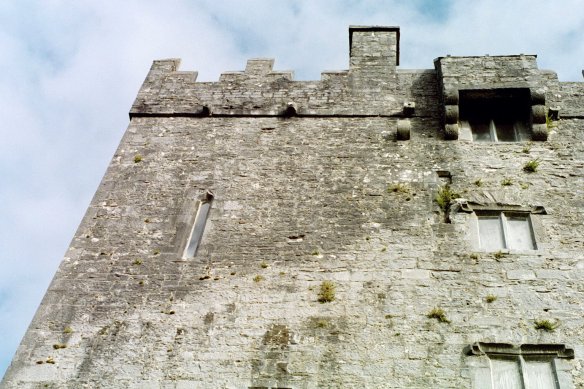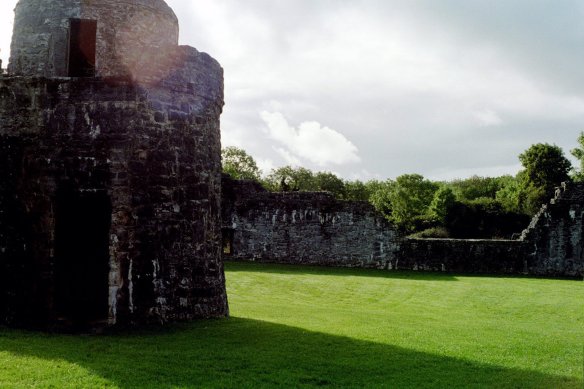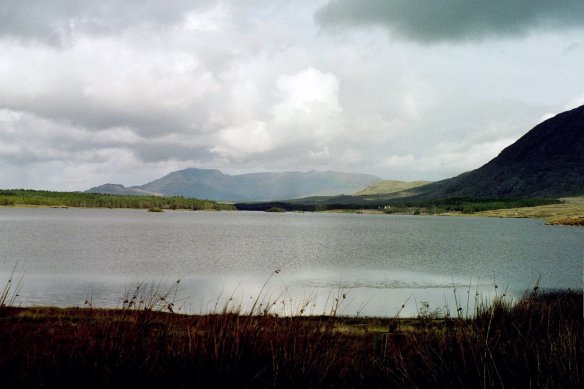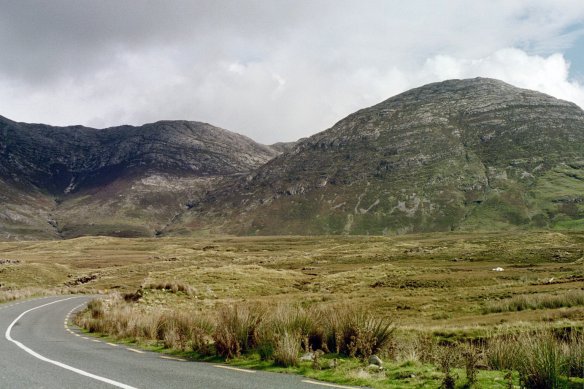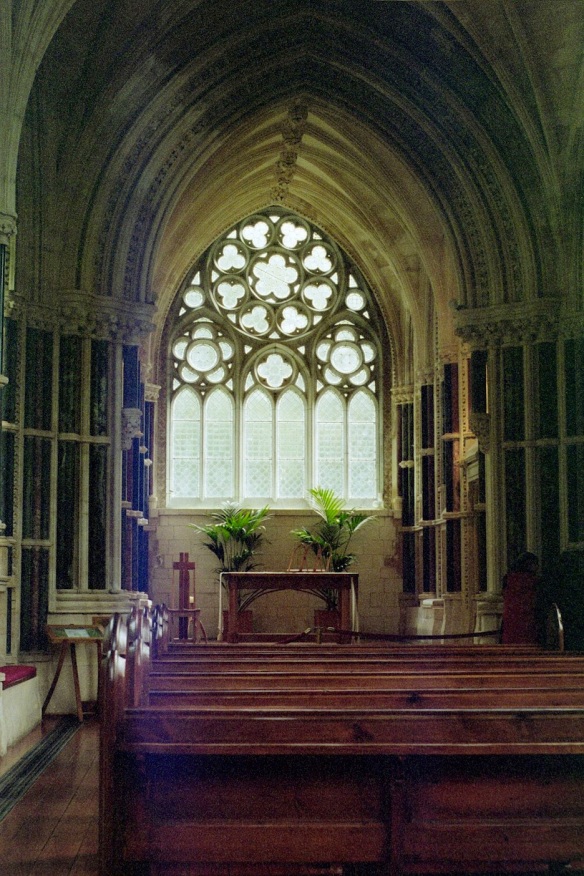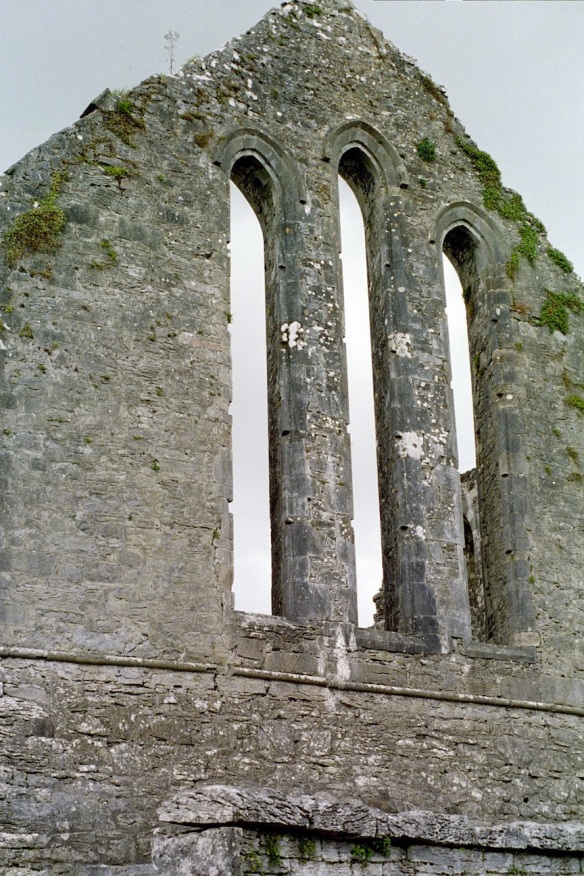Friday, 19 September 2003
Salthill, Co. Galway – Achill Island, Co. Mayo
The temperature was distinctly cooler the next morning. We backtracked into Galway during the morning rush hour, and then headed into Connemara. “This wild region in the west of County Galway,” the D-K Eyewitness Travel Guide says, “encompasses bogs, mountains, and a rugged coastline.” It’s dominated by a rocky mountain range known as the Twelve Bens. Lots of rocks, lots of sheep (and you thought I’d forgotten!) … and, of course, it is in the Gaeltacht, where Irish is still the first language.
Our first stop was Aughnanure Castle (pronounce this OCK-na-noor), a beautifully preserved example of a thirteenth-century tower house, situated on a gentle river that flows into the western side of Lough (pronounce LOCK, for lake) Corrib.

You can see a bit of the inner wall through the trees, and some of the outer wall here on the left; this was actually the landing, where they kept a dock and put in to the river … which is now a very slow-moving creek.
These homes were built by large, wealthy, land-owning families, mainly of Catholic Anglo-Irish or Gaelic Irish stock; they were fortified residences, with a high wall (or two, in this case) enclosing several buildings.
This particular home belonged to the O’Flaherty clan for over three centuries, who used it as a bastion against their neighbors to the south and east, particularly the citizens of Galway, who controlled access to the ocean from Lough Corrib, land which had once also belonged to the O’Flahertys. Apparently there was a lot of conflict between the two locations, as in the mid-1500s Galway’s city fathers erected a plaque over the western entrance to the town which read: “This Gate was erected to protect us from the ferocious O’Flahertys”!
The Irish countryside is dotted with these old tower houses, many of them deserted. They were ingeniously designed for a culture that was ruled by local chieftains who often had to protect hearth and home from attack, with projecting battlements, staircases spiraled in the direction to favor the sword-hand of the defender, and “murder holes,” which allowed defenders to drop stones on anyone who managed to enter the castle. The concept of the tower house was a good one… until the introduction of mobile artillery, which happened in the late sixteenth century.

This type of battlement is called a machicolation. Openings at the base allowed stones or burning objects to be dropped onto attackers.
From Aughnanure we headed up the N59, a narrow road (they all seemed to be!) that skirts Lough Corrib for miles.
The rain of the previous day was gone with the sea wind, leaving nothing but a few cumulous clouds behind. The lake was calm. I can’t even begin to describe the scenery—everywhere I looked, another gorgeous vista, and I took lots and lots of photographs, though for every one I took, there were a dozen lovely shots I didn’t take.

I mean, seriously. Just stunning country. Don’t forget you can enlarge these photos by clicking on them.
Past Clifden, we followed the signs to Kylemore Abbey, and spent over an hour here, in a sheltered lake valley. D-K says, “… this lakeside castle is a romantic, battlemented Gothic Revival fantasy … built as a present for his wife by Mitchell Henry, a Manchester [England] tycoon …” Construction was completed in 1868. The Henrys also planted thousands of orchard trees and created exotic walled gardens. But devastated after the sudden deaths of his wife and daughter in 1874, Mitchell left Kylemore and the castle was sold. “It became an abbey when Benedictine nuns, fleeing from Belgium during World War I, sought refuge” in Ireland and purchased the estate, which they now run as a select girls’ boarding school.
I have to tell you, it is an astonishing thing to be walking down the lane past the lake (it was like glass that day), round a bend, and see that huge house snuggled up against the mountainside—it looks like a dollhouse castle!

View from the parking lot. Wait for it … we’re going to stop right by that tree where the other couple is stopped. (Click to zoom in.)

Shift just a little to the left and the estate begins to come into view. See the tower on the far left? That’s the little gothic chapel. The lake was smooth as glass that day. (Click to zoom in.)
We could hear the sound of girls laughing, playing outside, as we went inside to view the home (the bit of it that is open to the public). Later we walked down the lane to the Neo-Gothic chapel; it’s tiny, but is a “cathedral in miniature,” complete with gargoyles, a crypt, and corner buttresses. Inside I counted at least nine types of Irish marble, used in the columns. This church was built by Mitchell Henry as a memorial to his wife.

Connemara is famous for its nine kinds of marble. I love that Mr. Henry used it to decorate the chapel.
Leaving Kylemore, we followed the signs to Cong (in Irish, Cunga, meaning narrow strip of land—and if you look at a map you’ll see why) and its famous abbey.
The Cong Abbey was built for the Augustinians in 1120 by Turlach Mor O’Conor, King of Connacht and High King of Ireland. In its heyday, it served as a hiding place for the O’Conor family, a hospital for the sick, shelter for the poor and starving, and was, of course, a place of learning for hundreds of scholars … until the abbey fell into ruin after the Dissolution of the Monasteries, which occurred 1536–1540.

Smaller church building, 2003. My photos are incomplete, but these are some good ones here.
You’ll recall that Henry VIII of England wanted a divorce from his wife, Catherine of Aragon. He spent a good five years pressuring the pope for an annulment, and when that didn’t work, he simply dissolved his relations with the Roman Catholic church and formed his own, the Church of England, of which he was, of course, the head. Problem solved! Then, since he needed money—didn’t kings always need money?—and didn’t want to impose taxes, which would have been unpopular, he began to confiscate the wealth and property of Catholic institutions in England and Ireland.
Not only did he confiscate the possessions and land of the monasteries, he also laid waste to the buildings, many of which are little changed since that era, although the Victorians later spent much time and effort restoring the larger sites such as Glendalough, Clonmacnoise, and others. And there were other effects: the thousands of servants attached to the monasteries were left without jobs and thus penniless. Additionally, the economic base of any town near the monastery was severely affected when the faithful no longer made pilgrimages—in other words, tourism fell off. But the biggest loss was cultural: many monastic libraries full of priceless illuminated manuscripts were destroyed, with little or no regard for their value.
Think about that.
Nonetheless, although this was the time that the Protestant Reformation was taking place in mainland Europe, the English Reformation was slow to gather steam: Catholics were not at first mistreated, and in many parts of the country, religious life went on unchanged. It wasn’t until Oliver Cromwell came on the scene one hundred years later and undertook to exterminate all Catholics that true religious hatred was ignited.
Cong has another claim to fame: it was here and in the surrounding countryside that the 1951 John Wayne movie The Quiet Man was filmed.
We didn’t linger long in Cong, since we had other places to see and somewhere else to be. I’ll save that for the next post. 🙂


